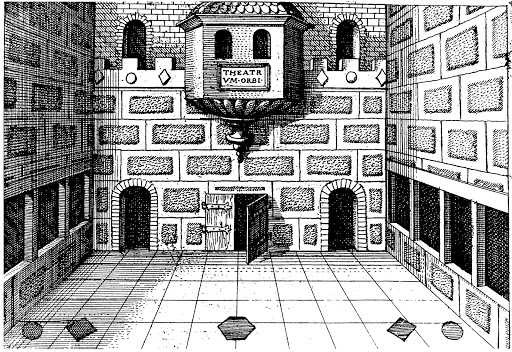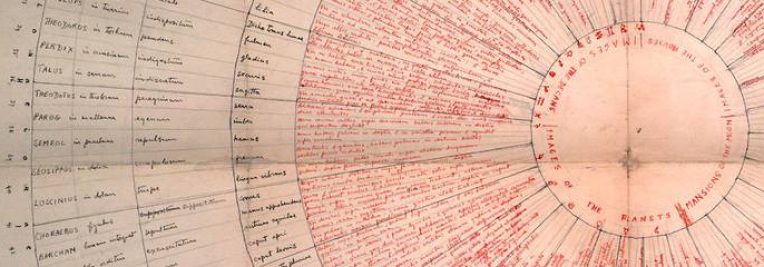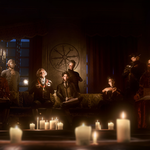This is the first review in a new series that will focus on esoteric texts modern and old, predominately from what is collectively known as the Western Mystery Tradition.
The Art of Memory (Ars Memoriae) is an esoteric practice that I had heard reference to in various places both specialist and mainstream, from the scholarly works of Dame Frances Yates through to the autobiography of Derren Brown, but it was never something that I had really paid close attention to.
With the release of this new book from Lewis Masonic, I was inspired to take the plunge into a practice that exists just underneath the topics of divination, mysticism and ceremonial magic usually discussed in relation to the Western Mystery Tradition today. Having overlooked the significance of this practice, I was delighted to be introduced to the subject in more detail and given the encouragement to start a practice of purposefully strengthening my memory.
The Hermetic Art of Memory is a new translation of two texts from the mostly unknown Scottish disciple of Giordano Bruno, Alexander Dicsone. Paul Ferguson has translated two (quite similar) texts entitled The Shadow of Reason and Judgement and Thamus – The Virtue of Memory, which have been provided in both their Latin and English forms with extensive reference notes.
The book also includes a preface on ‘Decoding Dicsone’ by Ferguson that proves invaluable to understanding the context and content of the texts that follow, as well as an excellent introduction by Martin Faulks. It closes with Appendices on the Mansions of the Moon; the 32 Decans of the Zodiac; along with closing notes on terminology, Dicsone’s sources and recommendations for further reading.
The introduction from Martin Faulks should be commended for providing an inspiring and lucid overview of the purpose of the Art of Memory, particularly in the context of existing between both meditative and magical practices. He provides some clear starting points, which are otherwise difficult to draw out from Dicsone’s texts alone, and I found it straightforward to implement the creation of a Memory Palace (also taking some inspiration from Robert Fludd) into my daily practice to great effect.
Likewise, Paul Ferguson’s preface to the translated texts provides some much-needed context and introduces the reader to the person of Alexander Dicsone and his relationship to his teacher Giordano Bruno. Ferguson gives a structure for what comes ahead, as Discone’s text is rather obtuse while also consisting of a 16th-century style that can make understanding his work difficult at times. The translation footnotes provided throughout are also truly invaluable, as without them the reader would be lost in a sea of classical references and quotations. These notes (hundreds of them) provide the reader with the ability to delve deeper into the subject matter, while also learning about the broader context of the work and its many inspirations.
This is important because Dicsone’s texts themselves are, ironically, perhaps the least inspiring element of the book for a reader not well versed in its influences (such as myself). Although there are two texts included, the latter (Thamus – The Virtue of Memory) is essentially a reworking of the earlier text. It builds upon Dicsone’s ideas with more detail and clarity, but also reuses a large amount of material from The Shadow of Reason and Judgement. Including both allows for an interesting comparison, certainly of great use to more advanced students and academics in this area, but can make reading through them feel redundant at times.
Both texts hold their ideas within the framework of an imagined dialogue with Socrates; presented with an arrogant, haughty dismissal of Socrates’ philosophy and personal integrity that can be amusing with its caustic tongue but in equal measure off-putting with its lack of humility. The structure of memory recollection discussed, though, is the real reason that we are interested in the texts and they do provide interesting insights – both as an insight into the 16th-century concept of memory and its importance, but also for those interested in a more practical use today.

Dicsone’s taxonomy of memorising Objects through Subjects/Shadows/Inflections with various modifications and types of each form is one that can readily be seen (and experienced) in application through the creation of your own Memory Palace. Robert Fludd recommends that a Memory Palace be of a location known to you (he used a theatre, likely the Globe, as can be seen in the image above), a physical reference point to help put the more metaphorical and allegorical items for memorisation within its corridors, rooms and halls. However, they can also be entirely imaginary or of a more illustrative and symbolic nature: such as the qabalistic Tree of Life or Bruno’s mnemonic wheel (shown in the header image).
The opening commentary and explanation of the system from Ferguson provides much needed clarity, because without it the text would be difficult to fully understand and work with. The translation into English is relatively easy to read, but when you consider the more abstract elements of what is being discussed you realise that the 16th-century mindset and reference points are quite different to what we have today. Not only is the deeper meaning difficult to grasp (even when translated well), but the examples that Dicsone gives to help the reader understand the method are unintuitive to a modern perspective.
Ultimately, what this means is that The Hermetic Art of Memory is not inherently a beginner’s text. It would even be considered a relatively obscure addition to the field best suited for advanced students; were it not for the power of the introduction, clarity of the explanatory material from Ferguson, and additional content included as Appendices. With these, the entire book comes together as one that can be used effectively by any aspirant relatively comfortable with the broad spectrum of the Western Mystery Tradition and therefore able to see how this skill would immediately enhance any esoteric practice.
A well-trained and effective memory provides the foundation blocks for confident and intuitive spiritual work; particularly when it comes to activities such as divination, contemplative meditation and ceremonial magic that are the cornerstones of the Western Mystery Tradition. For this reason, pursuing a more reliable and deeper memory capacity should be a goal for anybody seeking to journey down such a path. The concept of a Memory Palace, and the detailed instructions of how to build and use one successfully, are available to anybody with enough interest and discipline. This book provides both a useful inroad into the practice as well as an interesting addition of historical importance, even if Dicsone isn’t the most profound or inspiring example to be found.
Ars Memoriae is an area of esoteric study and practice that conjoins scientific and religious perspectives. It is an effective and replicable activity to pursue and the impact of its practice is measurable and readily defined, accessible to people of different mindsets and thoughts on the role we play as individuals within the wider universe. It is an esoteric practice open and useful to anybody who dedicates themselves to following through with its methods.
The Hermetic Art of Memory does not provide a text of seminal importance, as Dicsone’s work is both a bit off-putting in tone and murky in presentation while existing essentially as a revision of Giordano Bruno’s system. However, the publication provides a surrounding framework that will successfully inspire anybody who reads it to pursue the practice wholeheartedly. The practices briefly described within should be considered intermediate level; whereas the inclusion of the original Latin texts and extensive footnotes means that the content will still be useful (perhaps most useful) for advanced readers. When considered together as a whole, this book contains a lot of value for anybody serious about taking up the Art of Memory.
While the book is not an essential purchase, it is well worth a recommendation for anybody with a broad view of the different paths within the Western Mystery Tradition wanting to deepen their daily practice. It’s an even higher recommendation for any serious student of the Art of Memory or scholars of Giordano Bruno and his disciples, as it provides a unique contribution to the scholarship in these areas along with everything needed for an academic to use the texts with a critical eye.
If you want to start embodying many of the practices and ideas found in Western esotericism in a more structured and systematic way, then training your memory is not only a useful starting point but is ultimately one of the keys that unlocks the entire tradition. The Hermetic Art of Memory therefore provides an interesting and useful look into a still mostly obscured area of some of humanity’s most hidden and important endeavours.
Recommended
Practical Level: Intermediate
Content: Advanced
Purchase The Hermetic Art of Memory directly from Lewis Masonic on their website here.
Also Read:
Frances Yates, The Art of Memory
Giordano Bruno, De Umbris Idearum & Ars Memoriae





